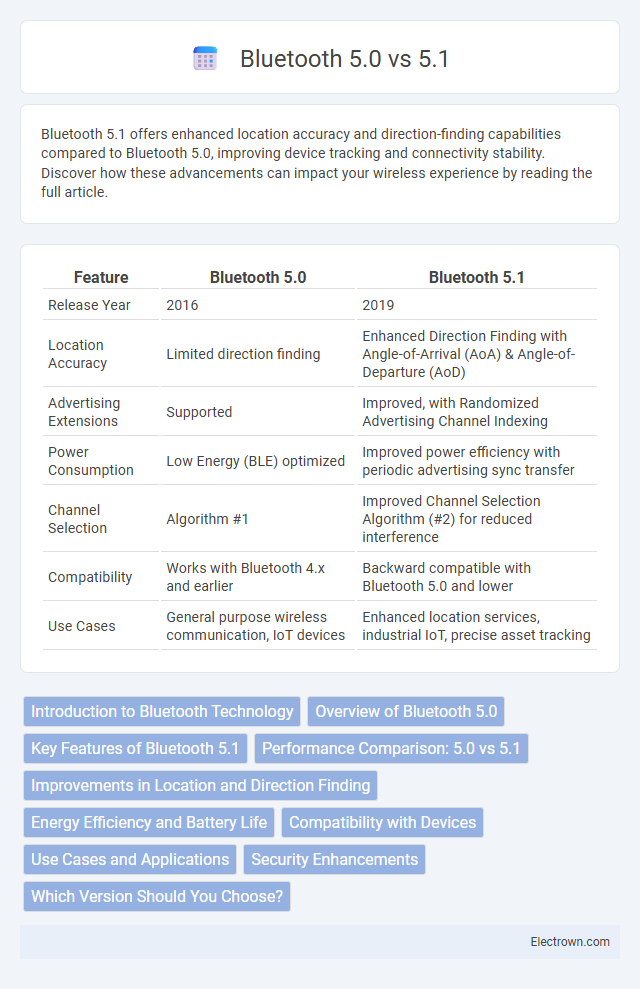Bluetooth 5.1 offers enhanced location accuracy and direction-finding capabilities compared to Bluetooth 5.0, improving device tracking and connectivity stability. Discover how these advancements can impact your wireless experience by reading the full article.
Table of Comparison
| Feature | Bluetooth 5.0 | Bluetooth 5.1 |
|---|---|---|
| Release Year | 2016 | 2019 |
| Location Accuracy | Limited direction finding | Enhanced Direction Finding with Angle-of-Arrival (AoA) & Angle-of-Departure (AoD) |
| Advertising Extensions | Supported | Improved, with Randomized Advertising Channel Indexing |
| Power Consumption | Low Energy (BLE) optimized | Improved power efficiency with periodic advertising sync transfer |
| Channel Selection | Algorithm #1 | Improved Channel Selection Algorithm (#2) for reduced interference |
| Compatibility | Works with Bluetooth 4.x and earlier | Backward compatible with Bluetooth 5.0 and lower |
| Use Cases | General purpose wireless communication, IoT devices | Enhanced location services, industrial IoT, precise asset tracking |
Introduction to Bluetooth Technology
Bluetooth 5.0 introduced significant improvements in speed, range, and broadcasting capacity compared to previous versions, enabling faster data transfer up to 2 Mbps and increasing the range to 240 meters in open space. Bluetooth 5.1 enhanced device location accuracy with Angle of Arrival (AoA) and Angle of Departure (AoD) features, allowing precise indoor positioning and improved direction finding capabilities. Both versions maintain backward compatibility while advancing wireless communication for IoT devices, audio gadgets, and smart home technology.
Overview of Bluetooth 5.0
Bluetooth 5.0 offers significantly improved data transfer speeds up to 2 Mbps and four times the range compared to previous versions, enhancing connectivity and performance in wireless devices. It supports increased broadcasting capacity, allowing your devices to send more data simultaneously for better efficiency and functionality. This version also enables improved coexistence with other wireless technologies, optimizing overall communication reliability in busy environments.
Key Features of Bluetooth 5.1
Bluetooth 5.1 introduces key enhancements such as Angle of Arrival (AoA) and Angle of Departure (AoD) for improved location accuracy, enabling devices to pinpoint exact positions within centimeters. It also supports Randomized Advertising Channel Indexing, which reduces interference and enhances connection reliability. Your Bluetooth-enabled devices benefit from faster pairing and more precise direction finding compared to Bluetooth 5.0.
Performance Comparison: 5.0 vs 5.1
Bluetooth 5.1 improves location accuracy with angle of arrival (AoA) and angle of departure (AoD) features, delivering precise device positioning up to centimeter-level precision compared to Bluetooth 5.0. Bluetooth 5.1 offers enhanced power efficiency through improved scan modes, reducing energy consumption during device discovery versus Bluetooth 5.0's standard scanning. Both versions maintain data rates up to 2 Mbps and similar range capabilities, but Bluetooth 5.1's advancements optimize connectivity and performance in complex environments.
Improvements in Location and Direction Finding
Bluetooth 5.1 introduces Angle of Arrival (AoA) and Angle of Departure (AoD) capabilities, enabling precise direction finding that significantly enhances location accuracy compared to Bluetooth 5.0. This advancement allows devices to determine the exact position of nearby Bluetooth-enabled objects within centimeters, improving applications in asset tracking, indoor navigation, and augmented reality. Bluetooth 5.0 lacks these direction-finding features and provides less precise location services relying mainly on signal strength measurements.
Energy Efficiency and Battery Life
Bluetooth 5.1 introduces improved energy efficiency features such as Enhanced Attribute Protocol (EATT) that optimize device communication and reduce power consumption compared to Bluetooth 5.0. These enhancements help extend battery life in connected devices, especially in wearables and IoT applications where frequent data exchange occurs. Bluetooth 5.1 also supports more precise location services with minimal additional energy use, further contributing to efficient battery management.
Compatibility with Devices
Bluetooth 5.1 enhances device compatibility by improving location services through Angle of Arrival (AoA) and Angle of Departure (AoD) features, enabling precise indoor positioning, which Bluetooth 5.0 lacks. Both versions maintain backward compatibility with previous Bluetooth standards, but Bluetooth 5.1's refined protocol increases interoperability with newer devices supporting these advanced features. The adoption of Bluetooth 5.1 ensures seamless connection stability and improved performance in complex device environments compared to Bluetooth 5.0.
Use Cases and Applications
Bluetooth 5.0 enables improved range and speed, making it ideal for wireless audio devices, smart home gadgets, and wearable technology with efficient data transfer. Bluetooth 5.1 introduces angle of arrival (AoA) and angle of departure (AoD) features, enhancing location-based services such as indoor navigation, asset tracking, and proximity sensing with higher precision. Both versions support low energy consumption, but Bluetooth 5.1's direction-finding capabilities open new possibilities for augmented reality and advanced beacon systems.
Security Enhancements
Bluetooth 5.1 introduces significant security enhancements over Bluetooth 5.0, including improved location privacy through Angle of Arrival (AoA) and Angle of Departure (AoD) features which help prevent unauthorized tracking. Bluetooth 5.1 also supports improved random number generation and encryption algorithms, strengthening protection against eavesdropping and man-in-the-middle attacks. Your connected devices benefit from more robust authentication protocols that enhance overall wireless communication security.
Which Version Should You Choose?
Bluetooth 5.1 offers enhanced direction-finding features and improved location services, making it ideal for applications requiring precise device tracking and navigation. Bluetooth 5.0 provides sufficient range and speed for general use, including audio streaming and smart home connectivity, with broad compatibility across devices. Choose Bluetooth 5.1 if advanced spatial awareness is critical; otherwise, Bluetooth 5.0 remains a reliable, cost-effective option for everyday wireless communication.
Bluetooth 5.0 vs 5.1 Infographic

 electrown.com
electrown.com